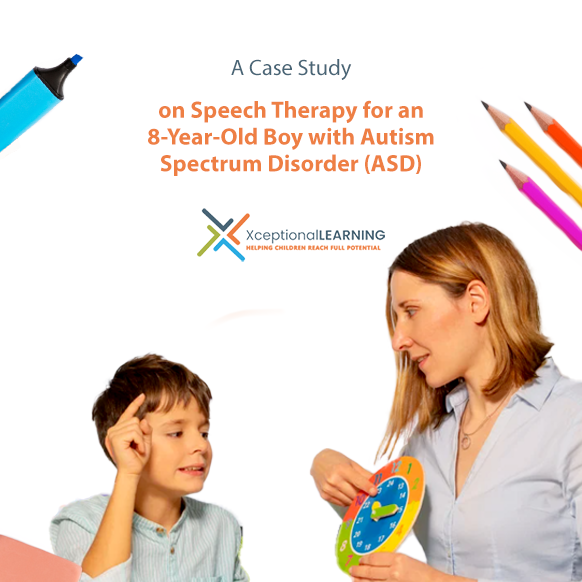Transforming Communication: A Case Study on Speech Therapy for an 8-Year-Old Boy with Autism Spectrum Disorder (ASD)
admin June 12th, 2024
– Written By
MASLP (Master’s in Audiology and Speech Language Pathology)
Consultant Speech Swallow pathologist, Digital practitioner -SLP
Introduction
Meet Mathew, an energetic 8-year-old boy diagnosed with Autism Spectrum Disorder (ASD). Through a combination of tailored therapy activities, Mathew has made impressive strides in his communication, cognitive, and motor skills. This blog will explore his journey, detailing the innovative and engaging activities that have contributed to his progress, and highlight the positive outcomes from his therapy sessions.
Understanding Autism Spectrum Disorder
Autism Spectrum Disorder (ASD) is a developmental disorder characterized by challenges in social interaction, communication, and repetitive behaviors. Children with ASD often have unique strengths and challenges, and personalized therapy plans are essential for fostering their development and helping them reach their full potential.
Mathew’s Therapy Activities
Mathew’s therapy sessions are designed to enhance his language skills, cognitive abilities, and social interactions through a variety of engaging activities:
1. Articulating Simple Words Ending with -am, -an, -in, -it, -at:
This activity helps Mathew practice pronunciation and improve his articulation skills, which are fundamental for clear speech.
2. Learning Word Families and Expressing Related Words:
By learning word families, Mathew enhances his vocabulary and understanding of word relationships, aiding in language development.
3. Narrative Tasks for Enhancing Expressive Language:
Narrative tasks encourage Mathew to construct sentences and tell stories, improving his expressive language skills.
4. Picture Description:
Describing pictures helps Mathew develop his observation skills, vocabulary, and ability to articulate his thoughts clearly.
5. Playing “Feed The Shark” Game for Linguistic Skills:
This interactive game makes learning fun while reinforcing Mathew’s linguistic skills and vocabulary.
6. Listening to and Answering WH Questions about Stories:
Stories like “Save The Elephant” and “Cat and Hat” help Mathew practice comprehension and answering WH questions, enhancing his listening and verbal response skills.
7. Performing Activities like Animal Race, How’s the Weather, Days of the Week:
These activities improve Mathew’s cognitive skills, understanding of daily concepts, and ability to follow instructions.
8. Reading Stories from Textbooks and Answering Questions:
Reading and comprehension exercises strengthen Mathew’s reading skills and ability to understand and recall information from stories.
9. Writing Spellings from Stories on the Whiteboard:
Writing exercises reinforce Mathew’s spelling and fine motor skills, helping him practice writing in a fun and engaging way.
10. Reading Provided Words and Sentences:
This activity aids in improving Mathew’s reading fluency and comprehension.
11. Engaging in Dancing (Dance and Freeze) and Gaming Activities for Cognitive Stimulation:
Dancing and gaming activities enhance Mathew’s motor skills, coordination, and cognitive stimulation through fun and interactive play.
Progress through Consistent Therapy
Mathew’s consistent engagement in these activities has led to notable improvements in various areas:
- Enhanced Articulation: Improved pronunciation and clarity in speech.
- Expanded Vocabulary: Broadened understanding of word families and related words.
- Better Expressive Language: Increased ability to construct sentences and tell stories.
- Improved Observation and Description Skills: Enhanced ability to describe pictures and articulate thoughts.
- Strengthened Comprehension: Better understanding of stories and ability to answer WH questions.
- Cognitive and Motor Skill Development: Improved cognitive skills and motor coordination through interactive activities.
Recommendations for Future Therapy Plans
As Mathew continues to progress, here are some recommendations for future therapy plans to further support his development:
1. Advanced Articulation Exercises:
Introduce more complex words and sentence structures to continue improving articulation and speech clarity.
2. Expanded Narrative and Storytelling Tasks:
Encourage Mathew to create and narrate longer stories to enhance his expressive language skills further.
3. Interactive Reading Sessions:
Use interactive books and reading apps to make reading sessions more engaging and interactive.
4. Social Skills Activities:
Include group activities and role-playing games to develop Mathew’s social interactions and cooperative play skills.
5. Creative Arts and Crafts:
Incorporate arts and crafts to improve fine motor skills and encourage creativity.
6. Sensory Integration Exercises:
Use sensory integration activities to help Mathew manage sensory sensitivities and improve overall sensory processing.
7. Parent Involvement:
Encourage Mathew’s parents to participate in therapy sessions and practice activities at home to reinforce learning and progress.
Conclusion
Mathew’s journey is a shining example of how tailored therapy activities can make a significant difference in the development of a child with Autism Spectrum Disorder. His progress highlights the importance of engaging, interactive, and consistent therapy in fostering growth and development. Mathew’s story inspires hope and demonstrates that with the right support, children with ASD can achieve remarkable progress. Thank you for joining us in celebrating Mathew’s achievements.
Take the first step towards a better tomorrow! XceptionalLEARNING Platform revolutionizes support for individuals on the spectrum with its advanced Virtual Autism therapy services. By utilizing cutting-edge technology, our platform ensures personalized, accessible, and effective therapy solutions that transform lives. Contact us today to learn more about our services and how we can help you achieve your therapeutic goals.

